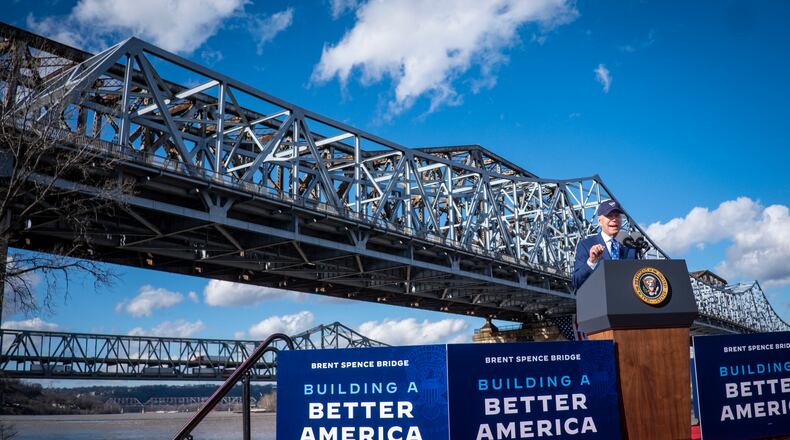“This is an important step forward in bringing efficiency to our nation’s supply chain,” Ohio Gov. Mike DeWine said in a statement. “The project will address one of the worst truck bottlenecks in the nation by improving safety and travel on an interstate connection that carries more than $400 billion worth of freight every year.”
The federal approval was described as a crucial step in remaking an eight-mile section of the Interstate-71/75 corridor between Kentucky and Ohio, stretching from the Western Hills Viaduct in Ohio to Dixie Highway in Kentucky. A new companion bridge will be built immediately to the west of the existing bridge.
Current estimates for the massive project split the costs, with $2 billion being paid by Ohio taxpayers and $1.6 billion by Kentucky.
“The Brent Spence Bridge Corridor project is a testament to what can happen when we work together to get things done,” said Kentucky Gov. Andy Beshear.
The federal government’s assessment evaluated the social, economic and environmental effects of the project.
KYTC and ODOT have conducted 16 neighborhood meetings and two open house events since late 2022 to solicit comments on the project plan. There is a formal project website at https://brentspencebridgecorridor.com/ which offers a flyover video of a projected design, as well as monthly e-newsletter updates.
Credit: Al Behrman
Credit: Al Behrman
The project was awarded $1.6 billion from the Bipartisan Infrastructure & Jobs Investment Act in December of 2022.
The Brent Spence bridge was constructed in the 1960s to carry some 80,000 vehicles a day, but the daily I-75/I-71 traffic load has doubled that in recent years.
“Because I-75 is a key freight corridor stretching from Canada to Florida, the congestion impacts commerce and commuters who travel the corridor in the eastern United States,” the joint Ohio-Kentucky release noted.
At a projected $3.6 billion, this is considered one of the biggest highway projects in the country and is expected to stretch into the next decade, at least until 2032 and perhaps longer. Earlier this year, project organizers expressed hope that “substantial completion” would be done by 2029.
The Brent Spence Bridge Corridor Project will include:
* Improvements to the Brent Spence Bridge, which will continue to carry local traffic to and from downtown Cincinnati and Covington.
* The construction of a two-deck companion bridge west of the Brent Spence Bridge to carry regional and national travelers through the area.
* Improvements to the adjoining eight-mile roadway network (three miles in Ohio, five in Kentucky), such as the redesign of ramp configurations to improve traffic flow.
* Amenities such as pedestrian and bike paths to connect communities and improve access to transit stops, jobs, healthcare, and more.
* Aesthetic improvements such as lighting, planters, and translucent screen walls on overpasses to instill a walkable, urban sense of place.
SOURCE: BrentSpenceBridgeCorridor.com
About the Author



